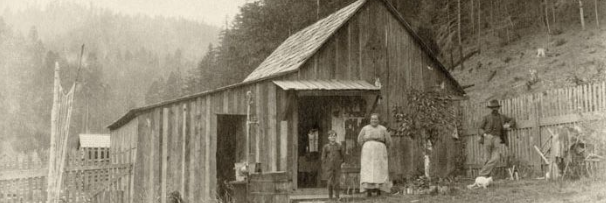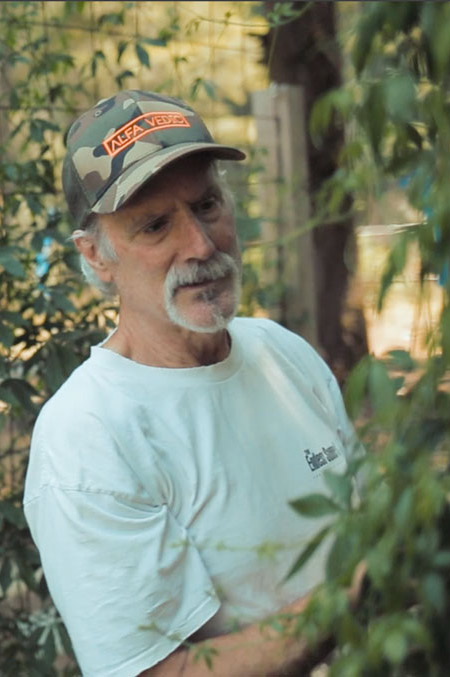
Homesteading
Public Group
Public Group
Active 2 months ago
A group dedicated to any and all aspects of homesteading and the homestead life.. Feel free to... View more
Public Group
Foraging & Wildcrafting
-
CreatorDiscussion
-
May 18, 2024 at 2:51 pm #390640

KevParticipantAll things regarding the hunting for food and medicine & such..
-
CreatorDiscussion
-
AuthorReplies
-
November 5, 2024 at 5:53 pm #401182

Todd & KateMemberVery nice, Kev! … We eat acorns, too! So far, we’ve only cold leached them after grinding them down into a fine flour. We then usually use the flour while still wet. We leach a batch at a time. Really cool to see you cold leach with a coarse grind so the acorns still have some shape to them. Thanks for sharing! …
We eat black walnuts, too! It is pretty much as simple as cracking them, although they are a tough nut to crack! If you don’t already do a float test with your nuts, I’d recommend that step for sure. After dehulling them (wear your stained fingers with pride!) put them in a bucket of water. The bad nuts float and the good ones sink. Then dry out the good nuts in shallow boxes. The walnuts taste better after they cure, in our opinion. … Crack em with a hammer or we got a Grandpa’s Goody Getter nutcracker, which our little ones can use. … Then, depending on how you feel about it, you can eat em straight up or soak and dehydrate them to neutralize the phytic acid. … They make a good nut butter, too, and no extra oil is needed. … Lots of black walnuts this year in WI, too 😃
-
November 5, 2024 at 6:06 pm #401183

KevOrganizerReally good advice in all of that!.. I wanted to grind the acorns into a flour before cold leaching, but I didn’t for the fact that straining ground nut water through a cheesecloth is nearly impossible in my experience.. Impossible task that makes an enormous mess.. But I wanted to do it that way so the flour was good to go.. But also, I have no way to dehydrate a flour at low temperature, so I went with cold leaching when still chunky.. But my experience with dried acorns is that when you grind into a flour, it comes out pretty gritty.. That’s why I wanted to do flour first, to see if that helped that situation.. But also, I don’t have a proper grain mill, just a coffee grinder.. a grain mill would probably do a better job I’m thinking..
I tried to crack some Black Walnuts last night and realized I’d have to use a hammer.. and getting the nutmeats out of the shell was like the Hickory nuts I grew up with in the woods — impossible!.. I was gonna go back and watch the videos I posted about Black Walnuts, but I think you answered my question.. Just cure them first and they’re easier to crack??.. How do you do that — just set at room temperature, or do you a small level of heat??.. my dehydrator isn’t big enough to hold that size of a nut..
Also, I did do the float test with the Acorns this year and they all floated, but most turned out to be good nuts.. So i’m not convinced yet on the float test.. And I didn’t realize that about the Black Walnuts (or it didn’t dawn on me), to soak out the phytic acid to make them taste better (though I like the bitter flavor, if that’s at all related).. I already soak and ferment whole raw almonds, which makes them soooo much easier to digest..
Speaking of which — fermented Black Walnut seed cheese.. doesn’t that sound yums??.. 🤠
-
November 6, 2024 at 8:27 am #401219

Todd & KateMemberNice, Kev! … We have a nice grain mill for the acorn flour. After leaching, we strain out the water through an organic cotton sheet (no flour makes it through that) instead of a cheesecloth. … Hmmm, I guess the float test has some flaws. Thanks for sharing your experience floating the acorns.
Room temperature is fine for curing the walnuts. Just don’t pile them too deep on each other. Shallow boxes, like the boxes that the grocery store gets their cases of strawberries and grapes in, work great. … Getting all the nut meats picked out after cracking still isn’t the easiest thing, but hopefully you’ll find your rhythm after not too long. … Some Amish by me prefer to resoak the nuts before cracking so the nut meats don’t crush as easy, but are more pliable and easier to remove from the shell without breaking. … Removing phytic acid doesn’t seem to change the flavor like removing tannins does. It just has to do with the digestibility, like you said with the almonds. … Yums yums!
-
November 7, 2024 at 10:22 am #401263

KevOrganizerWell it’s clear to me why Black Walnuts are so expensive in grocery stores (you know, the little bags in the baking isle you sometimes see).. They’re so difficult to shell!.. I’ve said that forever about common wild Hickory nuts — they’re not economically viable for sale because they can’t be shelled easily.. except for pecans of course, which are technically a Hickory.. Love me some Pecans, could eat them all day & night.. And hey, if you ever get into fermenting ground raw nuts & seeds (the “seed cheeses” I mentioned), you’ll find that they go through major flavor changes.. Equal parts sesame and sunflower can produce a flavor that’s just like Parmesan (the bitter sesame in there).. and sweet nuts turn a lot sweeter (pistachio, pecan, hazelnut).. English walnuts experience a big flavor enhancement that I found combines well with sunflower too.. And raw Pumpkin seeds are simply off the chart.. That’s a mind bender, those.. They’re already delicious as is, but, next-level.. Lol..
Well, a grain mill isn’t on my list of things I can afford, so I’mma still give them a go in the coffee grinder and do a bread.. I got that sweet bread to try (though that calls for an addition of rice flour, which I’d like to avoid; though I do have some coconut flour).. Do you by chance have a recipe for a basic savory acorn bread you like??.. I just had the thought of doing acorn cookies, sorta like a sugar cookie, or cinnamon snickerdoodles, maybe.. would be good with maple syrup.. Thinking maybe a dough that could be rolled into little balls (there’s a cookie recipe I’m not remembering the name of, but they’re little balls that are soft and crumbly and hold their shape at the same time).. Hmmm, I wonder if cacao powder would combine well with acorn.. What say you??
-
November 8, 2024 at 6:00 am #401308

Todd & KateMemberSeed cheeses sound fun, thanks for sharing! How do we learn more? … We haven’t done any acorn breads yet, but have done pizza crust, pie crust, muffins, torts, cookies and pancakes! All really yummy! We’ve mixed in cacao with cookies and the tort, and it was fantastic! There’s a book by Alan Bergo (The Forager Chef) called, The Book of Flora, which has tips on leaching and such plus some great recipes. Highly recommended! Plus, if you don’t know of Samuel Thayer’s books and work, you have to check him out (although he is WI based and focuses on the eastern states). He doesn’t do recipes, but he’s a wealth of wisdom. His book, Nature’s Garden, has a great 50-page chapter on Acorn.
-
November 8, 2024 at 3:28 pm #401340

KevOrganizerI have heard of Thayer.. Thanks for those book titles.. 50 pages on acorns alone?.. 🙂
And I’m gonna experiment with combining acorn flour, cacao & maple syrup, probably coconut oil, concoct something, see what happens.. 🙂
Seed cheeses are easy.. First thing is you have to capture lacto-bacteria from your environment, and once you have them (in water), you can store them in the fridge and use for fermentation, or just drink it (“probiotic” drink)..
You just need some sort of starch.. I’ve used wheat berries, as well as any dried legume, as well as raw almonds.. I might’ve used millet one time.. Just soak whatever you’re using in water.. I always go a full 24 hours, and change the water after about 12 hours.. (but don’t rinse and flush away whatever bacteria starts to grow).. After 24 hours, I pour off the soaking water again (but again, I don’t rinse).. At that point, I add water again and let it sit and grow for up to a full day (sometimes less, or much less, depending on how it develops).. The water will be slightly cloudy, have a slight tangy aroma, and sometimes you’ll see bubble on the surface.. And if you tap the jar, carbon dioxide bubbles will be released.. (Note: after the first 24 hours of soaking, the water should already have a culture growing and be cloudy & tangy, but I typically dump this for the fact that it’s still initial soaking water, and can still include phytic acid or whatnot, so I dump it, and give it fresh water).. Sounds involved, but it’s really not.. Very easy — mostly just sitting and soaking..
Once you have the lacto-bacteria water, store it in the fridge.. and to make seed cheeses, add some to finely ground seeds and/or nuts (all of which must be raw; toasted nuts/seeds don’t work).. I *always* add salt.. And you have to add extra water to thin it out and make it a creamy mix.. (I’ve always found that the bacterial culture only needs to be a portion of the total water added.. just a portion of the total is adequate).. And then let this ferment at room temp for 12 hours to 2 days, depending on conditions/temps, the concentration of your culture, and how much you use, etc.. You’ll have to play by ear, but still very very easy.. Oh, the culture needs to breathe.. So I use mason jars with sprouting lids on top (with holes), and drape the jar with kitchen towels to keep in the dark.. Important note: a good culture will expand up to twice in volume (or more), so I recommend not filling a jar more than half full.. You’ll see carbon dioxide pockets form in the mix, and eventually, hopefully, it’ll expand like a balloon.. Good signs!! .. 🙂
-
November 12, 2024 at 8:10 am #401536

Todd & KateMemberAwesome, Kev! Thanks for all that inspiration! … We found some reference to seed cheeses in our Sandor Katz “Art of Fermentation” book, including a reference to acorn seed cheese. Here’s what was said, “Acorns (ch’int’aan) were the staple food of the Naahneesh, and many other peoples of California. They were eaten in three main forms: acorn mush/soup (sk’ee’), acorn bread (t’ast) and fermented acorn/acorn cheese (ch’int’aan-noo’ool’, ch’int’aan tghaat).” … We’ll be sure to let you know how our first seed cheeses go, when we try them. Really looking forward to it! 😃
-
November 13, 2024 at 2:48 am #401609

KevOrganizerYeah, I’mma go through some of the vegan gluten-free type recipes I have around here somewhere, for inspiration.. I’m hot on this idea of acorn-chocolate cookies with maple syrup.. I just need a reference point, and I’ll go from there.. We’ll seeee.. 🙂
-
November 14, 2024 at 12:28 am #401681

KevOrganizerHey Todd & Kate.. a little bit of an update for you.. I’ve had my acorn cheeses in the fridge without touching them for about a week, so they’ve been aging.. My acorn-sunflower mix has developed into a sharp hard cheese flavor — reminds me quite a bit of Asiago.. Soooo good.. Now I’m thinking to go out and do another acorn gathering.. Don’t have to crack them and can store them, maybe just keep them in a box with good air, and I’ve seen using a dehydrator to help cure them for long-term storage.. I’ve got far too many things to do.. Lol..
-
November 14, 2024 at 12:05 pm #401709

Todd & KateMemberAwesome! We’ll definitely have to try an acorn seed cheese of some sort, too. Acorn will be the first one we try 😃
-
November 14, 2024 at 12:28 pm #401711

KevOrganizerWow, going straight for the gold.. Lol.. I *definitely* recommend experimenting, especially with combinations.. Half-sunflower-half-sesame is one of my go-to’s, and pumpkin seeds are hard to imagine.. 🤠
And man, if y’all got black walnuts, do those!.. I’ve yet to find the time to forage those myself, so not sure if that’s happening.. Would be interesting to see how the bitter develops through fermentation..
-
-
-
-
-
November 5, 2024 at 8:16 pm #401197

KevOrganizer
-
-
November 11, 2024 at 7:27 pm #401507

KevOrganizerHey y’all.. So, any of y’all out doing any foraging this time of year??.. I’ve been collecting lots of seed heads, but frustrated being in the city and not having easy access to digging things up, like thistle roots (you know, the private property situation).. But, have been collecting a massive amount of Dandelion greens on the daily for eating.. Amaranth too.. Collected a bunch of Plantain herb for drying, and pulled a Plantain out of the ground and got that potted up at home.. Lots of green leaves to be had at the moment.. In some respects, “too much to get to”.. Lol.. Plants are thriving in the cool moist weather, in their autumn growth period.. 🤠
So what y’all up to??
-
November 12, 2024 at 12:16 pm #401552

MikeMemberMade an awesome grain bowl for dinner last night with local wild chanterelles, a bunch of greens from the garden (3 kales, mustard, Chinese cabbage & chard), last of the summer squash and an egg from our chickens but would love to get better at sourcing more wild harvested greens!
-
November 13, 2024 at 2:42 am #401608

KevOrganizerI hear ya!.. I’m actually not very knowledgeable on edible wild greens.. I look around and think, is that edible?, that one?, surely that’s tasty, etc.. I know a few, but I know there’s certainly way way more.. Right now, dandelion and chickweed are the two best going here for completely wild plants (burdock leaves too) that I really know for certain.. otherwise, you’re cutting nasturtium leaves from someone’s front yard along the sidewalk.. Lol.. and I keep forgetting to give fresh Plantain leaves a nibble.. Those are prolific, everywhere..
Oh yeah, and lucky you with the Chantarelles!.. Lots of mushrooms everywhere, but as we know, not to be messed with if you don’t know them for certain.. There’s a rotting tree trunk 2 blocks from here in the park that’s imbued with Turkey Tail mushrooms.. I went today to see if they were poppin’, and someone had already cut the ones from the spots where I know they emerge.. But lots of others starting the fruit out.. So, in about a week, hopefully, Turkey Tail for tincturing!..
Just today out on my morning walk was able to get a big bag of fallen fruit that’s still good (apples & pears).. and dang them pears were the size of softballs and off the scale sweet and delicious.. Persimmons are coming on finally, and yet another fruit everyone ignores.. But when they fall, I swoop in.. like a hawk..
Oh, hey, Mike — do you have any wild fruit and/or nut trees there on your land??.. I’m assuming you have some woodlands.. Do Oregon Filberts grow in that region??
I’m so broke right now that the daily haul of dandelion greens are my veggie intake.. and who’s complaining?!.. Not me.. Most nutritious leafy green on Earth.. 🤠
-
November 13, 2024 at 10:44 am #401632

MikeMemberWe have a ton of wild berries here from blackberry, raspberry, huckleberry, oregon grape & gooseberry but this time of the year the wild fruits get pretty minimum however I am still finding huckleberries. We have wild pomme fruit trees all over the place as well but most are done by now. As for mushrooms I can verify on my own a number now including chanterelles, black trumpets, morels, snowballs & all the coniferous types. Look what we ran into last weekend!
-
November 13, 2024 at 3:59 pm #401653

KevOrganizerAh, so you eat Oregon grape berries too.. One of my favorites!.. I made vinegar out of ’em this past summer, and that’s phenomenal.. Would never be short of the root tincture either, if I could dig them!..
I’m guessing the pomme fruit is maybe some sort of wild apple tree..
You’re way ahead of myself on mushroom identification.. I had access to a very large book on mushroom identification and foraging years ago (out in the woods in southern Oregon), and it was clear that you have to be really really careful, especially since some species look just like others that are deadly poison.. I did a major collection out in the woods one day, brought in dozens of varieties, and still too many questions about what’s what.. But, there are the obvious ones, and I still gotta learn..
And I’m guessing that’s the red-capped mushroom of Siberian Reindeer Games fame.. yes??
And I live for blackberries.. That was most of my summer — picking & hauling in gallons at a time (literally, one or two gallon jugs every few days).. Lol..
Oh, almost forgot.. A little over a year ago, I found fresh Lions Mane mushrooms at a local grocery mart, and I set up a natural grow operation on my balcony — filled a couple troughs with soil and topped with pieces of deadwood, and sprinkled Lions Mane spores on them (which come from the hairs on the outside of the mushroom).. I read that they grow on deciduous hardwoods (oak, maple, beech, etc.), either alive or dead/decomposing.. i.e. they don’t grow in soil.. The wood I collected was hopefully mostly deciduous (but difficult to ascertain for sure).. But, have tried to mimic natural forest conditions as much as possible — no direct sunlight, kept them outside in the heat of summer, in full shade, with not much water.. Now they’re getting rained on.. No Lions Mane fruiting after more than a year.. Still holding out for those.. 🙂
And, finally, I tasted fresh Plantain leaves today and they a’ight, a little grassy.. Put some in my dandelion cook-up today.. Yum..
-
-
-
-
-
November 15, 2024 at 11:47 pm #401808

KevOrganizerBeen absolutely lovin’ Dandelion and Plantain greens recently, eating a load of fresh greens everyday, cooking them up together.. Plantain is a bit grassy, but delicious all the same.. Gathered a massive amount of Plantain today for dehydration.. Been loving its energy recently as a medicine.. For sure, a tincture’s coming out of this batch.. 🙂
-
December 17, 2024 at 10:06 pm #404305

KevOrganizerHey y’all.. Black Walnut tofu.. dang, looks good.. @ToddKate ..Todd & Kate!.. I thought you guys would like to see this.. 😉 .(short video).
-
December 23, 2024 at 2:23 pm #404749

Todd & KateMemberNice! We’ll have to remember that one. We definitely have the black walnuts. That’s the first step! 😃 … Thanks for thinking of us! Looks good!
-
-
December 21, 2024 at 6:50 pm #404593

KevOrganizerHey y’all.. need some help from fellow foragers on some mushroom identification.. I’ve got at least one local source of Turkey Tail (not pictured here).. I’m pretty sure it’s Turkey Tail, but the young small fruiting bodies are flimsy and don’t have solid white underbellies (at least yet).. So the question is: does that white underbelly develop over time??..
Then I discovered a second log of what appear to be Turkey Tails (pictured here).. They have solid white underbellies, and I know there’s big variability in coloration.. So, you think this is Turkey Tail, or one of the many very close lookalikes??
Also, on the same log are these 2 other white fungi.. Anyone got any idea what they are??.. Appear to be 2 distinct species.. Thanks y’all..
-
December 22, 2024 at 6:01 pm #404699

KevOrganizerDecember 22, 2024 — second day of winter.. Out on a walk today, came across this apple tree.. Most of the apples on the tree *and* the ground were in almost perfect condition still.. I snagged a few, but, um, homeowner was home.. and a heavy load, had errands n thangs n hauling to do.. had to stop the forage before it was too heavy.. 🙂
-
December 24, 2024 at 6:04 pm #404800

KevOrganizerAlfie’s back.. 15 more wild edible plants.. this is a good one, and I learned several things here.. especially #14 & #15 — Wood Avens (Geum urbanum) and Salsify.. The Wood Avens is *everywhere* where I live, and didn’t know it was edible…. And I’ve been eating a *lot* of wild Plantain the past few months.. it’s everywhere.. And looking forward to spotting several of these, such as Beech nuts & wild garlic, and wild Ribes (Gooseberries, which are very common here, but they never seem to produce fruit).. 26-minute video, worth it..
@alfawarrior ..Hey Mike.. I came back to this posting to tag you in case you didn’t see it.. I recalled that you mentioned you want to learn more on wild edible greens.. Alfie covers at least 5 fresh greens in this video (maybe more, can’t recall), but several were new to me, and stoked to have learned them..
-
January 10, 2025 at 3:42 pm #405622

KevOrganizerI saw these red berries everywhere during this past autumn season, and they looked delicious, but I didn’t dare give a taste test, until I knew the what’s what.. Looked ’em up.. Turns out, it’s the Kousa Dogwood tree (Cornus kousa), sometimes called Chinese Dogwood.. (and also a bit embarassed, as it would be obvious it’s a dogwood tree).. But, super edible, with variable flavor.. There’s about one tree on every block where I live.. Next year.. next year..
-
January 21, 2025 at 6:59 pm #406298

MikeMember-
January 21, 2025 at 9:20 pm #406302

KevOrganizerOo oo oo, how many pages?, and nice color photos?.. I wanna see!
-
January 22, 2025 at 8:01 am #406351

ElizaMemberI agree and I’d love photo updates with the sections of the. Oils when you find something and..Mike, this reminds me that…what I didn’t explain well enough about the EMF frost at the end with the angle / angel emoji…
I am tempted to send you a small microscope 🔬 they are so cheap and zoom 1kx magnification…and I just wondered if the frosty response to the many waves was…just a more invisible (but beautiful) fractal design on a smaller scale….i used to have one and it was so fun to look at stuff in nature anytime! Another great AV merchandise idea: children’s exploration box — haha if these cost 20-30 retail…I wonder what they cost in bulk…
-
January 22, 2025 at 7:56 pm #406387

KevOrganizerOh Lord, Eliza, now you got me thinking I need a microscope that takes pictures.. sheesh, no money, no time, no patience to deal with the internet hassle of looking for one..
Had a microscope when I was a kid.. one made in the ’60s, old school.. I used to look at pond water.. 🤸♂️
-
-
-
February 25, 2025 at 9:27 am #408215

KevOrganizerMike, you raved about this book in the recent podcast, so now my interest is particularly piqued.. Might you have a moment to snap some photos and give us a peek??.. And hey, just did a cursory search of books on foraging in the PNW.. too much, and I just had to “step away”, as I’d get lost in that gopher hole, salivating over all of ’em.. But this book here of yours, that might be one I acquire myself.. 🙂
-
-
February 18, 2025 at 10:47 am #407822

JenaMemberWow you guys are my peeps….love to get a microscope….testing my soil for healthymicrobes n bugs!
-
February 25, 2025 at 1:19 pm #408260

KevOrganizerKudzu.. When I lived in the deep south as a lad, Kudzu was everywhere and demonized.. A member of the legume/pea family, and very edible (jellies & syrups made out of the flowers look yum).. Hardy to 20 degrees F or so (-7 C), which is why it’s isolated to the SE of the US.. Oregon’s climate would be perfect for it, but I don’t dare introduce it here; though I have wondered how it’s escaped being brought here.. (Instead we got introduced English Ivy devastating the native forests)..
Got Kudzu??.. here’s what you can do with it..
-
February 26, 2025 at 12:24 pm #408319

KevOrganizerA beautiful and reverent 17-minute video on Moss.. not necessarily about foraging for food & medicine, and the utilitarian.. but great value nonetheless in its energy, beauty, and spirit.. I’m partial and simpatico, as I live in a rainforest where Moss grows on everything.. so lovely.. and I most definitely use it in the garden..
-
March 30, 2025 at 9:41 am #410496

KevOrganizerMight be my favorite wildflower — Speedwell.. So lovely, and an herbal heal-all..
-
March 30, 2025 at 12:42 pm #410514

ElizaMemberIt reminds me of creeping Charlie which is a popular seed in wildflower mixes and grows a lot in our yard. I’m not sure why anyone would want to get rid of it as the results came-up…
But some speedwell would awesome cool to mix in. I’m a bit cheap these days about buying and spreading seeds due to the mangey chickens though.
Foraging was the topic of the local Edible and Ramps were featured front and center…
-
March 30, 2025 at 7:11 pm #410528

KevOrganizerLordy, I have so much to learn on foraging wild foods.. so much.. chompin’ at the bit over here.. so much on my plate — how do I find the time?.. But, um, Speedwell is everywhere here, and has been in bloom since first week of February or so.. I transplanted some into my potted garden last year.. it overwintered, but seems to have crapped out recently, not showing signs of coming back.. Wildflowers like that do *not* like being transplanted or propagated from cuttings..
But I did pull up a little bit of Creepy Charlie last summer and so far, it’s coming back.. Has always been a favorite of mine as well.. But I did look into its identity last year and found a common name, but I forgot it.. Not sure if it was CCharlie, and looking at all those Glechoma species, I haven’t found exactly what I have.. The one that grows around here isn’t quite what I’m seeing online.. Very similar, but very different — for one thing, it has lovely red/bronze coloring in the leaves.. When it starts growing/flowering this spring, I’ll photo it & show you, and do a reverse image search (but will likely get back CCharlie).. Hmmm, it’s still different though..
But also, the chickens can’t get to all your wildflowers, so cast lots & lotsa seeds!.. Toots style.. 😉
-
-
April 9, 2025 at 9:02 am #411101

KevOrganizerOo oo oo, this is a good one.. A North American wildflower with a starchy, edible tuber — “Fairy Potatoes”, aka “Spring Beauty”.. Never heard of this one, nor can I say I’ve ever noticed it growing wild.. Very informative 20-minute video from Jesse at Feral Foraging..
-
April 14, 2025 at 8:09 am #411458

Ann-Marie ShapiroMemberIm interested to hear from others who are familiar with Spring Beauties. They grow here in Illinois, as part of the spring ephemeral splendor of our deciduous woodlands. My impression of this plant is that it is very small, delicate, thin, spread out- they don’t grow into dense clumps like lily of the valley or even mayapple. They can spread but not rigorously in my experience. I’ve never noticed a patch spread. I would be surprised if these can be located in Illinois natural spots in enough abundance to sustain any degree of harvest (even if it was legal to take them). I wouldn’t ask them to stand between me and my hunger, in other words. My opinion is that there must be other sources of wild starch that would easier and more “productive” in terms of food provided per unit land or unit of human effort. Maybe it is different in other locations. Illinois is 99.9% profoundly modified landscape.
Ann-Marie
-
April 14, 2025 at 4:25 pm #411497

KevOrganizerHmm, interesting feedback.. thanks for that.. this video was literally my first time hearing of these, and all I can go on is the photos I saw in the video, which included some large patches of naturalizations.. So I dunno how prolific or widespread they typically are found.. As far as starchy tubers that are wild (or can be naturalized easily), my go-to at this point is Sunchokes (tuberous sunflower).. infamous for naturalizing and “taking over”, which would be the point in putting them in the ground, at least for me.. when I get a piece of land, Sunchokes will go in the ground pronto.. (right now I got some in large pots, and they don’t particularly care for that confinement)..
-
April 14, 2025 at 5:31 pm #411505

Ann-Marie ShapiroMemberI’m eager to get sunchokes planted! I have space to plant and permission to plant on others’ lands as well… But struggle for the time! I literally grieve for my lack of time to enact so many dreams and enthused interests. 🌻 Here’s for that future land under your feet and unencumbered time stretching out before me! (I do manage to grow potatoes and sweet potatoes each year, but definitely want to enjoy the multitude of features of the sunchokes!
-
April 14, 2025 at 6:51 pm #411523

KevOrganizerSunchokes, as I’m sure you’re aware, are reported to be zero maintenance (except digging to eat).. I grew Yukon Gold potatoes many years ago on a whim, just stuck some taters in the ground — each one turned into a dozen.. was easy, hardly ever thought of them.. Never done sweet potatoes.. Haven’t had a proper garden in a loooong time..
-
April 14, 2025 at 9:11 pm #411533

Ann-Marie ShapiroMemberI grow accidental perennial potatoes by failing to remove all of the potatoes from the ground during harvest. Love my little potato patch!!!! I’m going to try to massively increase potato harvest this year. Time will tell. My daughter loves them and it’s a powerful way to help her connect to the land just a bit.
-
April 15, 2025 at 6:08 pm #411590

KevOrganizerWhat’s her age?
-
April 15, 2025 at 7:30 pm #411595

Ann-Marie ShapiroMemberShe’s 24. She was raised so close to the land but I truly failed by not knowing the dangers on the online world. I’m such an idealist, I was enjoying the very best of the Internet back in the 90’s and then totally distracted by attachment parenting, divorce, survival, etc… and have low affinity for tech in general so just didn’t keep up as things changed. I allowed my daughter to use the freedom of unschooling to become addicted to her smart phone. Definitely not the worst mistake I made in those days, but I regret it deeply and I think it has been significant in breaking her connection to the earth.. she enjoys camping and hiking but those are “events” seeking peak experiences.(At least she has that! ) Day to day, she basically ignores the natural world completely unless I directly engage her somehow. Maybe her child will shift that a bit!!!!
-
-
-
-
April 18, 2025 at 12:21 pm #411760

Todd & KateMemberHi! Not sure if this applies to spring beauty too, but we learned from Sam Thayer that there are plants, like sunchokes, that spread more in response to you harvesting them, or digging them up, or disturbing (stimulating) the soil around them. The patch can diminish over the years without your interaction, but can increase with it. Food for thought! Happy Spring! ~Todd
-
April 18, 2025 at 2:19 pm #411770

KevOrganizerMakes sense!.. I’ve found most plants respond positively with new growth when you disturb them in some way, typically pruning/cutting and transplanting, and even disturbing the roots by digging next to them.. I’ve seen plants put out aggressive new growth with any of these.. It’s like a refresher.. and it then makes sense why some say you can dig up all your Sunchokes in autumn and just put them back in the soil until you’re ready to pull them out to eat.. the rest will be set for the next grow season.. I thought, why not just leave them alone and dig only what you need when you need?.. Makes more sense now, a constant refresher, and they’re obviously not negatively impacted by uprooting..
-
April 18, 2025 at 6:18 pm #411788

Ann-Marie ShapiroMemberYes, that’s a great reminder! My grad school advisor made his name documenting that phenomenon in a wild Arabidopsis in response to being browsed in Arizona! A beautiful example of abundance and synergy. Certain animals do the same in response to higher depredation. I actually hadn’t thought about that angle in awhile. Thank you.
-
-
-
-
AuthorReplies
Log in to reply.





